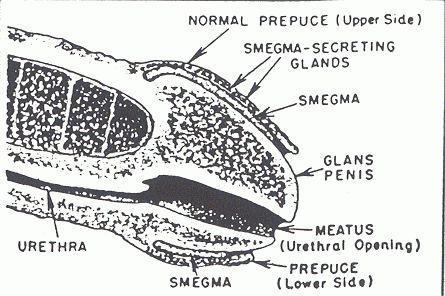Just What Is Smegma And Why Does It Make Us Cringe?

Smegma. It’s a word that once you have the faintest idea of its meaning, you can’t help but recoil and shriek out a reflexive “eww” into the endless void of the universe. It’s oozing, crusty, and utterly foul-smelling. Or at least that’s what many of us mistakenly assume it is.
So in order to separate fact from fiction, here’s the lowdown on smegma and why it’s not as awful as it sounds.
A Friend By Any Other Name
Strictly defined, smegma is the end result of dead skin cells and fatty oils primarily shed from certain parts of our genitalia; the inner cavity of the foreskin in men and the folds of the labia minora and clitoris in women. But its waxy, sometimes smelly, composition has lent it a much more provocative nickname: dick cheese. If ever there were two words you wouldn’t want in the same sentence, let alone next to each other, it’s those two.
But smegma is far from some godforsaken curse of humanity, at least usually. First things first, as ticking and tocking animal bodies, we excrete oil and water from our skin all the livelong day, and for good reason. The oily byproducts, known as sebum, coat our skin against microbial invaders and keep the skin waterproof. Likewise, smegma serves its own purpose. Namely, it helps lubricates our genitals during sex. Particularly in uncircumcised men, it helps ensure that the foreskin can easily slide on and off the glans, or head, of the penis without irritation (though cut fellows still produce it). And it’s not just a human thing, all mammals make and use smegma to their heart’s content.

Coming Out In the Wash
So where does the abject disgust toward smegma come from, aside from our general fear of anything related to our genitalia? Much like other begroaned bodily secretions like armpit sweat, it’s about cleanliness. When we regularly clean our genitals, smegma is transparent and unnoticeable, but when we don’t, it becomes opaque, white or yellow, and most of all, rank. The gunk comes from the build-up of dead skin cells trapped in the foreskin or vagina, while the smell comes from the bacterial breakdown of the oils. Harmless bacteria, not so harmless waste products. So in that very horrifying sense, smegma actually has plenty in common with cheese.
As to why we associate it with male genitalia, that’s likely because teenage boys and young adult men are an embarrassment to hygiene. Less insultingly, the level of smegma production shoots up throughout puberty and into adulthood but generally lowers the older we become, which makes sense considering its function in sexual intercourse. Not to worry, though, Dr. Joyce Wright, in an 1970 article about smegma in Sexology, assures us that in some men, "the penis remains well preserved and functional even into extreme old age." Joy. Boys who are reluctant or even ignorant about the need to regularly roll back and clean their foreskin as they mature might also explain smegma’s smelly reputation.
But there’s no need to bombard our junk with industrial-strength detergent to get rid of smegma. Just some nice warm water, and maybe a little soap every once in a while. If anything, constantly soaping down there will only make everything dry and irritated, which I’m sure no one wants.
Can smegma cause cancer?
In a word, no. But plenty of people have tried to figure out if it can. In the 1940s and 1950s, it became the latest scientific craze to gather smegma, sometimes from elderly men or horses, and douse mice in it. Just to see what happened. Thinking on it, that might literally be humankind’s worst scientific accomplishment. In a 2006 review of the smegma-cancer link published in the Journal of the European Academy of Dermatology and Venereology, the authors succinctly concluded that, "The evidence does not support the theory that smegma is a cause of genital cancer."
That said, aside from ensuring that you’ll never know the touch of a romantic partner, letting smegma build-up can be bad for your health. In severe cases, it can cause balanitis, or inflammation of the glans, by irritating the penis. Which, ow. This again tends to happen among the younger crowd.
Lastly, despite its name and early findings, mycobacterium smegmatis isn’t found in smegma, though it has been an invaluable source of knowledge due to its close relation to the worrisome germ that causes tuberculosis. Considering that the bacteria is actually located in soil, that only brings up the question of how early scientists found it in smegma in the first place. A question I never want answered.
As the 2006 review notes, it wasn’t just the smell that made people so dead set on finding a link between smegma and disease. It was the perception of sex as a dirty-minded hobby. In the 19th century, it was old hat to declare the very act of masturbation an abject sin, and along the way, both smegma and the foreskin were similarly demonized as unclean and degenerative to human health. That hysteria has mostly abated, but we’re still left with the idea that smegma is an unpleasant, unneeded part of our anatomy.
Nuts to that, I say! Evolutionarily speaking, we owe a great debt of gratitude (and our sex lives) to smegma. As long as we keep ourselves clean, there’s not a damn thing wrong with it. So next time you hear the word, instead of cringing in horror, you should instead mentally fist-bump the little oily secretion that could.
On second thought, that’s a really weird image. Just maybe not be so freaked out by it.



























